
Written by Chef James
So much of our focus on food is on its health benefits and flavor, but it’s really important not to undermine the whole experience of eating. When food is visually appealing, it stimulates our digestive juices, which help us maximize our body’s absorption of the nutrients while increasing the pleasure we experience from eating. It’s not just a nicety – proper food presentation can actually aid your digestion!
Does this mean you need to eat at 5-star gourmet restaurants to give your food a visual boost? Not at all. These are some simple tips you can easily and quickly use in your kitchen to make it as much a visual delight as anything else.
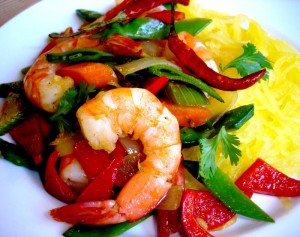
Beautiful, bright colors. Irresistible.
1.) Use colorful foods
Think reds, greens, yellows, blues, and purples. The more color you have on your plate, the better. This technique has the double benefit of being nutritionally superior. Each color represents a different set of nutrients and when you ‘eat by the rainbow’ you’re ensuring your body gets the widest variety of nutrients possible.
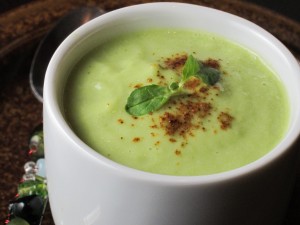
A sprig of mint and dash of paprika add beautiful color.
2.) Add a colorful garnish
If your dinner itself isn’t that colorful, add a garnish that is. Fresh herbs, spices and zested citrus make great colorful garnishes. For example add some fresh green parsley or cilantro (or other fresh herb) to a meat dish; sprinkle bright red paprika on eggs; add lemon zest with some cracked black and red pepper to salmon.
3.) Stack it
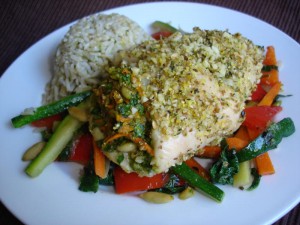
Stacking the protein on top of the veggies adds visual appeal.
Rather than spreading your food out over your plate in little heaps, stack it. This adds the third dimension of height and can transform a really simple meal into something fancy. Consider a basic meal of asparagus, salmon, and a quinoa pilaf. You could just lay these out next to each other willy nilly, or you could plate it with the asparagus fanned out on the bottom, the salmon resting on top of it crosswise, with a little scoop of quinoa in the “v” formed by the two.
Typically we start with greens on the bottom, then protein over the greens or layered half-on half-off the greens, and if you’re doing a starch, have a very small portion placed slightly off to the side in the nook made by the protein and greens.

Check out that quinoa!
4.) Shape it
Use measuring cups, measuring spoons, ice cream servers, or any other shaped ‘frames’ from basic tools in your kitchen as molds. In the example above, you could use a 1/3 cup measuring cup to form the quinoa, making a little quinoa round. If you’re concerned that the food will stick to the mold, oil it slightly with either coconut oil or olive oil, depending on the flavor of the dish.
5.) Choose appropriate dishware.
Think about both the shape and the color of your dishware. If your food is nice and bright, a white dish allows the food to pop whereas a colored or patterned dish would visually compete with the food. If the food is a uniform color (e.g., a leek soup), then a patterned dish would offset this nicely.
6.) Serve food on warmed or cooled dishes
Presentation isn’t just a visual thing – it’s also sensory. If you’re serving a cold salad, it tastes so much better on a chilled plate. Not only does it “feel” better, it preserves the salad’s freshness. If you’re serving a warm soup, pre-heating the bowl will add a whole other layer of comfort.
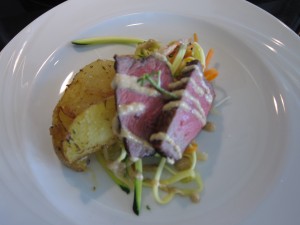
The perfect (small) amount of deliciousness, artfully sauced!
7.) Go small
Be mindful of the serving size. It’s always better to serve small portions and allow people to get seconds rather than serving too much food initially. Think of fancy restaurants – they always err on the size of smaller portions. This has the nice side benefit of helping with portion control, and if there are leftovers, they aren’t contaminated by being on people’s plates.
8.) Get creative with sauces
Re-use old squeeze bottles (that old mustard bottle or honey teddy bear) for dispensing sauces. If you want to get really fancy, you can even squeeze some sauce on the plate before adding the food.
Got some creative presentation ideas of your own? We’d love to hear them! Please share in the comments below.


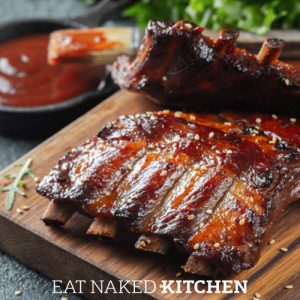
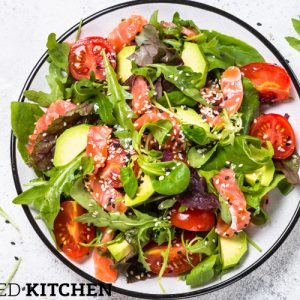


I love this post! I’m always playing around to find ways to be creative with my food and this helps me take it to the next level. Getting fun ideas already….
These are wonderful tips. Even the most novice cook can take the lessons and learn at home. Thank you Chef James. – Tonette
I saute spinach in oil and garlic, place on plate, put mashed potatoes/carrots (mashed in) on top of spinach, place a little arugula, then Miso Salmon with a pinch of chives on top.
Served with broccoli and Capresse salad with fresh basil and beets.
Great meal, great visual to guests.
Sounds delicious! And I bet it looks gorgeous 🙂